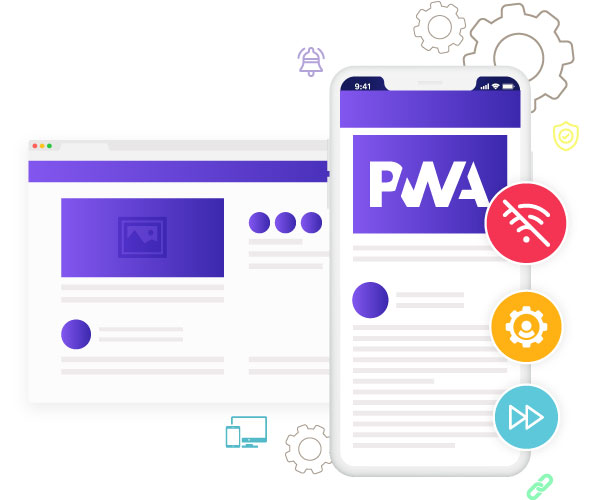Progressive Web Apps are a cost-effective medium to provide users with an enhanced customer experience. For many years, the customers live with the following preaching “You need a native app”.
However, native apps work well for businesses that want to retain customers and bring in loyal customers. You can give them an optimal mobile experience and communicate with them easily.
On the contrary, the native apps do not allow businesses to engage with the new users who can drop at any time. It is not easy to prompt them to download your app. Progressive web apps emerge as a winner, keeping in mind the value of such customers.
Read this blog to know more about the key PWA statistics that can influence your business decisions.
Contents
What are Progressive Web Apps?

With the increase in Mobile Phone usage by more than 60%, users want a faster browsing experience that is free of any frictions and hindrances. In such a scenario, Progressive Web apps are much faster and efficient. Also, PWA works best not only for e-commerce brands but for new businesses that want to engage users to grow their rankings
PWA apps need no installation and are great for website owners as well. The users can install the websites as apps to their devices’ home screens. These apps have unlimited potentialities such as faster loading, offline access, works even in the flickering connectivity issues, background updates, and viable access to the device camera.
Apart from being the first choice of leading companies such as Uber and Pinterest, PWA apps are less time-consuming in terms of their development. A developer needs a JAVASCRIPT code to create them.
Click Here For More What is PWA
To build a PWA, you must meet the following three criteria:
1. HTTPS:
PWAs shall run on servers that are secure such as HTTPS. Their potential lies in the hands of the service worker. Also, one can only use them when you have HTTPS in place.
2. Service worker:
It is a JAVASCRIPT file that runs separately, and it enables the developer to handle the network requests. The process helps to pull off the astounding speed and offline potentialities of Progressive Web Apps.
3. Web App Manifest:
It is a JSON file that describes the app to the browser, which includes the details of the author, description, and resources to run it.
What are The Key PWA Statistics?
Above were some of the surprising PWA statistics that helped the brands reap out many benefits are not the above facts. The blog must have inspired you to turn your website into PWA; if it does, then go for it to increase user engagement and a lot of other things.
A) User Engagement:
- PWAs boast 36% higher conversion rates compared to native apps.
- User engagement increases by an average of 180% with PWAs.
- Push notifications on PWAs drive a 250% boost in user re-engagement.
- PWAs see a 146% higher click-through rate on ad campaigns.
B) Performance:
- 54% of users abandon websites that take more than 3 seconds to load.
- PWAs load in under 2 seconds, significantly reducing bounce rates.
- PWAs use 60% less data than native apps, saving users money and bandwidth.
- PWAs can function offline, allowing users to access content even without an internet connection.
C) Business Benefits:
- Developing a PWA is 3-8 times cheaper than building a native app.
- PWAs require 33% less maintenance compared to native apps.
- PWAs reach a wider audience, catering to over 6.3 billion smartphone users globally.
- PWAs can achieve 50% higher conversion rates than traditional mobile websites.
D) Ecommerce:
- E-commerce PWAs see a 20% increase in time spent and product browsing compared to mobile websites.
- Average order value on PWAs can be 10% higher than on mobile websites.
- PWAs can reduce abandoned shopping cart rates by up to 35%.
- Jumia saw a 9x increase in conversions from abandoned carts using push notifications on their PWA.
E) Other Industries:
- Travel PWAs experience a 3x increase in conversions.
- News PWAs enjoy a 20% increase in returning users.
- Job portals using PWAs see a 15% rise in job applications.
- PWAs improve accessibility for mobile users with disabilities.
F) Additional Statistics:
- Only 54,000 websites currently utilize PWAs, leaving a vast market potential.
- PWAs have 60% fewer security vulnerabilities compared to native apps.
- 70% of users prefer PWAs over native apps due to their ease of installation.
- 80% of users add PWAs to their home screens for convenient access.
- The PWA market is expected to reach $10.44 billion by 2027.
Conclusion
After learning these PWA statistics, you may have realised how important PWA and how you can leverage it for your business. Since you have understood how PWA plays a crucial role you can prepare your strategies accordingly.
Also Read:

























 Email
Email SMS
SMS Whatsapp
Whatsapp Web Push
Web Push App Push
App Push Popups
Popups Channel A/B Testing
Channel A/B Testing  Control groups Analysis
Control groups Analysis Frequency Capping
Frequency Capping Funnel Analysis
Funnel Analysis Cohort Analysis
Cohort Analysis RFM Analysis
RFM Analysis Signup Forms
Signup Forms Surveys
Surveys NPS
NPS Landing pages personalization
Landing pages personalization  Website A/B Testing
Website A/B Testing  PWA/TWA
PWA/TWA Heatmaps
Heatmaps Session Recording
Session Recording Wix
Wix Shopify
Shopify Magento
Magento Woocommerce
Woocommerce eCommerce D2C
eCommerce D2C  Mutual Funds
Mutual Funds Insurance
Insurance Lending
Lending  Recipes
Recipes  Product Updates
Product Updates App Marketplace
App Marketplace Academy
Academy

